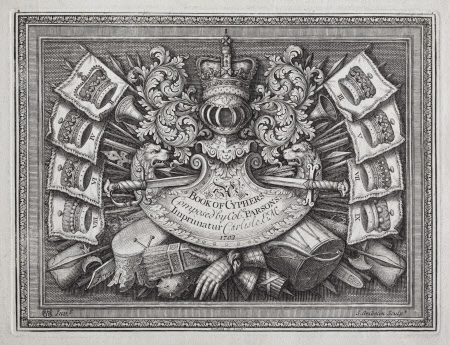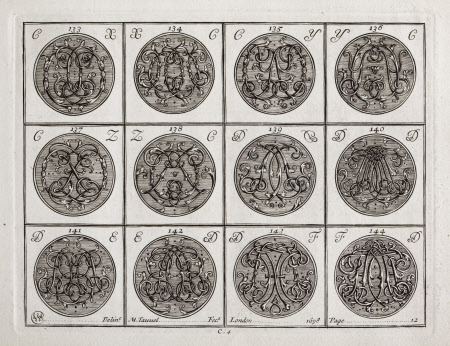A new book of cyphers; : more compleat and regular than any yet extant. Wherein the whole alphabet (twice over) consisting of 600 cyphers, is variously changed, inter-woven, and reversed; with the coronets of England, by allowance of the Earl Marshal. As likewise some examples for the ready composition of any cypher, consisting of 3.4 or more letters; with ornaments suitable to most occasions. Being a work very entertaining to such as are curious; and useful to all sorts of artificers in general. The whole (with the English translated into French) engraven on 56. copper-plates. / Composed by Colonel Parsons.
Colonel William Parsons (1658-1725)
Category
Books
Date
1704
Materials
Place of origin
London
Order this imageCollection
Anglesey Abbey, Cambridgeshire
NT 3070900
Summary
William Parsons, A New Book of Cyphers, London: printed for the author, 1704. Binding: Twentieth-century full dark blue crushed morocco; Clifton armorial stamp on upper and lower covers; single gilt fillet to form an outer border; four false bands; spine lettered direct (gilt tooled): 'A book of cyphers'; gilt fillets on board edges and turn-ins; gilt textblock edges. Binder's stamp on turn-in on front pastedown: Birdsall & Son Northampton.
Full description
Ciphers, in this context meaning initial letters superimposed and intertwined to make an intricate tendril-like design, became popular in England in the late seventeenth century. Like crests or arms, they were a way of denoting identity and ownership; distinctive, but intelligible only to the ‘cognoscenti’. They had the additional advantage that, whereas arms and crests were only available to the elite, anyone with access to pen and paper could make a cipher of their initials. Parson’s ‘New Book of Ciphers’, the fourth such book printed in England, contains engravings of 600 two-letter ciphers, and instructions on how to use them to compose longer examples of three or four letters. Parsons comments severely in his preliminary ‘Advertisement’ that the earlier works on the subject only contained half the number of ciphers necessary to complete their alphabets. The inclusion of plates illustrating the various coronets used with the crests or arms of the nobility demonstrates the cipher’s close link with heraldry. Parson’s strictures on the ‘Gross Mistakes Committed by Coach-Painters, Carvers, &c.’ in ‘the Coronets (which amongst the Nobility are always Used with Cyphers, Crests, &c.)’ give a hint as to how and where these designs were employed. The younger son of a baronet and an alumnus of Christ Church, Oxford, Parsons entered the army in 1682 and took part in the Glorious Revolution (1688). Returning to civilian life for a period, he turned to publishing, and seems to have taken a particular interest in popular works of learning. His translation of Guillaume Marcel’s ‘Tablettes chronologiques’ (chronological tablets listing the dates of kings, popes and emperors) was a great success and ran through many editions. He also entered into a partnership to produce a new set of globes (though none survive) and was hailed (by his partner) as ‘the Great Encourager of Artists’. He commissioned Michel Tauvel, an engraver based in the Strand, to begin work on his cipher designs in 1698. Work proceeded slowly over the following years, and permission to print the complete work was finally given in 1703. The finished book, engraved throughout, includes a fine frontispiece, engraved by Simon Gribelin to parson’s design, and a title-page and text leaves, in both English and French, by Joseph Nutting. Parson’s own cipher is visible in the bottom left-hand corner of each leaf. Text adapted from William Hale's entry in ‘Treasures from Lord Fairhaven’s Library at Anglesey Abbey’, 2013, cat. 8, pp. 58-9.
Bibliographic description
*iv, 48, **iv leaves : ill. ; obl. 4to. Pencil number "11745" on rear pastedown. Loosely inserted: (1) typescript card with basic bibliographic information; (2) cutting from book-dealer's catalogue for this work, with price cut out. Provenance: Twentieth-century crest bookplate: Urban Huttleston Rogers Lord Fairhaven [i.e.: Urban Huttleston Broughton (1896-1966)]. Binding: Twentieth-century full dark blue crushed morocco; Clifton armorial stamp on upper and lower covers; single gilt fillet to form an outer border; four false bands; spine lettered direct (gilt tooled): 'A book of cyphers'; gilt fillets on board edges and turn-ins; gilt textblock edges. Binder's stamp on turn-in on front pastedown: Birdsall & Son Northampton.
Provenance
Acquired by Huttleston Rogers Broughton, 1st Lord Fairhaven (1896-1966) and then bequeathed by him to the National Trust with the house and the rest of the contents in 1966.
Makers and roles
Colonel William Parsons (1658-1725), author
References
Mark Purcell, William Hale and David Person, Treasures from Lord Fairhaven’s Library at Anglesey Abbey, Swindon: National Trust; London: Scala Arts & Heritage Publishers, 2013., pp. 58-9

